HI6028 Taxation Law Assignment: CGT, Income, Deductions, and Tax
VerifiedAdded on 2022/11/13
|8
|1700
|233
Homework Assignment
AI Summary
This assignment delves into Australian taxation law, focusing on Capital Gains Tax (CGT), income from personal exertion, and deductions. It analyzes scenarios involving the sale of collectibles like antique paintings, historical structures, and jewelry to determine CGT liabilities. The assignment also examines income derived from personal exertion, such as payments for writing a book and selling copyrights. Furthermore, it explores whether payments received constitute assessable income and the tax implications of an excess payment made as interest on a loan. The document applies relevant sections of the ITAA97 and ITAA36, and case law, to provide comprehensive answers to the questions posed. This assignment provides a detailed analysis of complex taxation issues and applies taxation principles to real-life problems, making it a valuable resource for students studying taxation law.
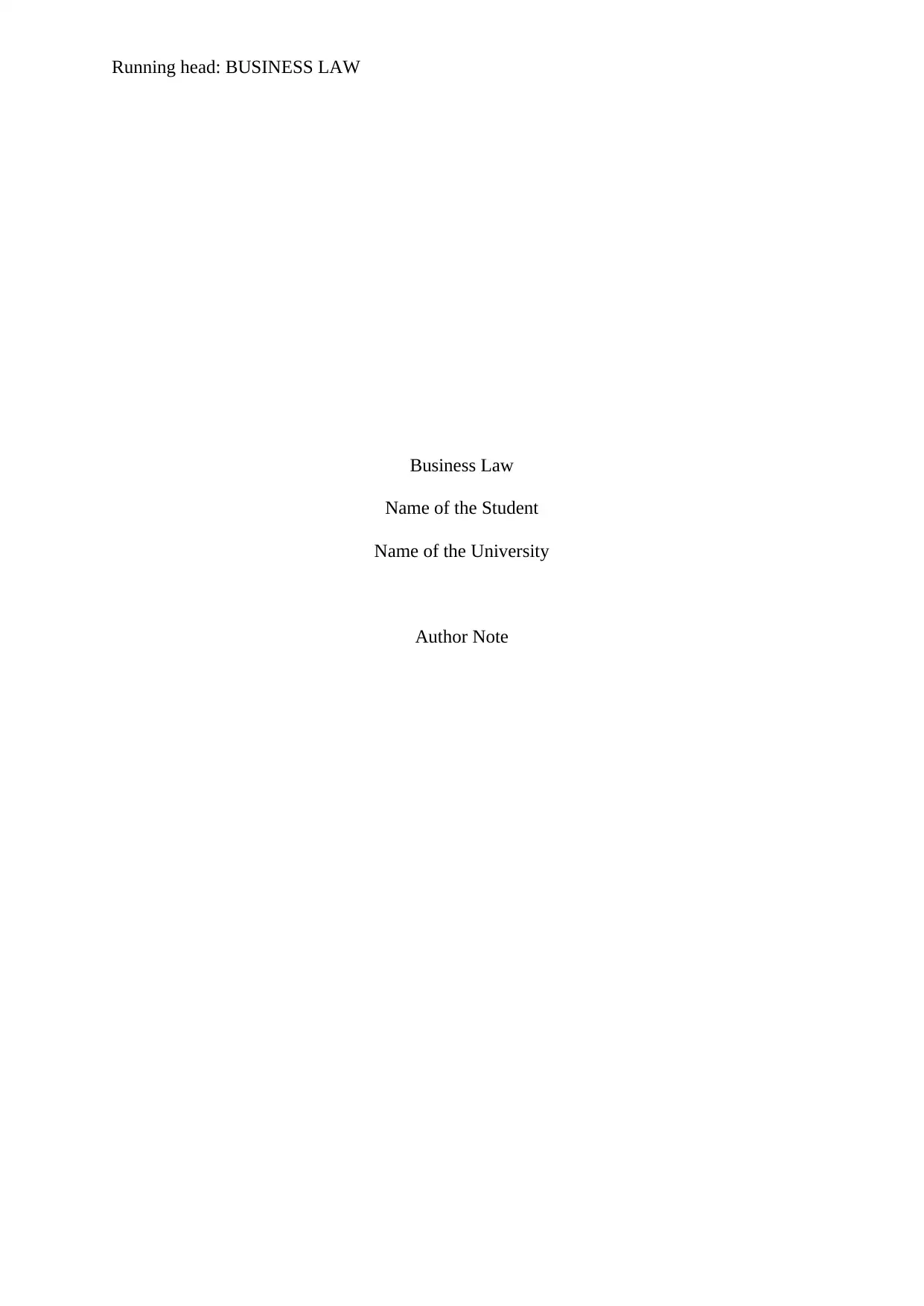
Running head: BUSINESS LAW
Business Law
Name of the Student
Name of the University
Author Note
Business Law
Name of the Student
Name of the University
Author Note
Paraphrase This Document
Need a fresh take? Get an instant paraphrase of this document with our AI Paraphraser
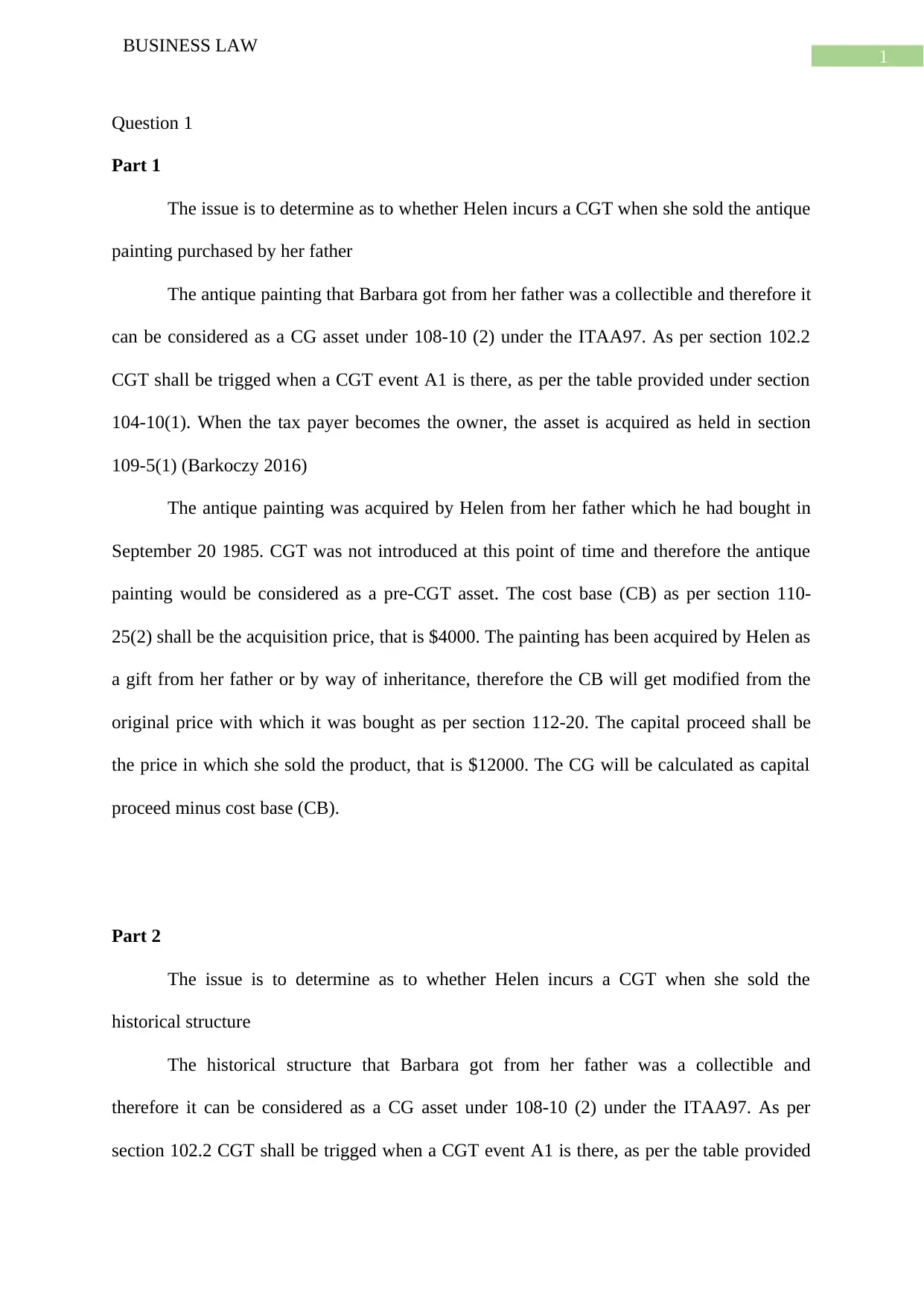
1
BUSINESS LAW
Question 1
Part 1
The issue is to determine as to whether Helen incurs a CGT when she sold the antique
painting purchased by her father
The antique painting that Barbara got from her father was a collectible and therefore it
can be considered as a CG asset under 108-10 (2) under the ITAA97. As per section 102.2
CGT shall be trigged when a CGT event A1 is there, as per the table provided under section
104-10(1). When the tax payer becomes the owner, the asset is acquired as held in section
109-5(1) (Barkoczy 2016)
The antique painting was acquired by Helen from her father which he had bought in
September 20 1985. CGT was not introduced at this point of time and therefore the antique
painting would be considered as a pre-CGT asset. The cost base (CB) as per section 110-
25(2) shall be the acquisition price, that is $4000. The painting has been acquired by Helen as
a gift from her father or by way of inheritance, therefore the CB will get modified from the
original price with which it was bought as per section 112-20. The capital proceed shall be
the price in which she sold the product, that is $12000. The CG will be calculated as capital
proceed minus cost base (CB).
Part 2
The issue is to determine as to whether Helen incurs a CGT when she sold the
historical structure
The historical structure that Barbara got from her father was a collectible and
therefore it can be considered as a CG asset under 108-10 (2) under the ITAA97. As per
section 102.2 CGT shall be trigged when a CGT event A1 is there, as per the table provided
BUSINESS LAW
Question 1
Part 1
The issue is to determine as to whether Helen incurs a CGT when she sold the antique
painting purchased by her father
The antique painting that Barbara got from her father was a collectible and therefore it
can be considered as a CG asset under 108-10 (2) under the ITAA97. As per section 102.2
CGT shall be trigged when a CGT event A1 is there, as per the table provided under section
104-10(1). When the tax payer becomes the owner, the asset is acquired as held in section
109-5(1) (Barkoczy 2016)
The antique painting was acquired by Helen from her father which he had bought in
September 20 1985. CGT was not introduced at this point of time and therefore the antique
painting would be considered as a pre-CGT asset. The cost base (CB) as per section 110-
25(2) shall be the acquisition price, that is $4000. The painting has been acquired by Helen as
a gift from her father or by way of inheritance, therefore the CB will get modified from the
original price with which it was bought as per section 112-20. The capital proceed shall be
the price in which she sold the product, that is $12000. The CG will be calculated as capital
proceed minus cost base (CB).
Part 2
The issue is to determine as to whether Helen incurs a CGT when she sold the
historical structure
The historical structure that Barbara got from her father was a collectible and
therefore it can be considered as a CG asset under 108-10 (2) under the ITAA97. As per
section 102.2 CGT shall be trigged when a CGT event A1 is there, as per the table provided
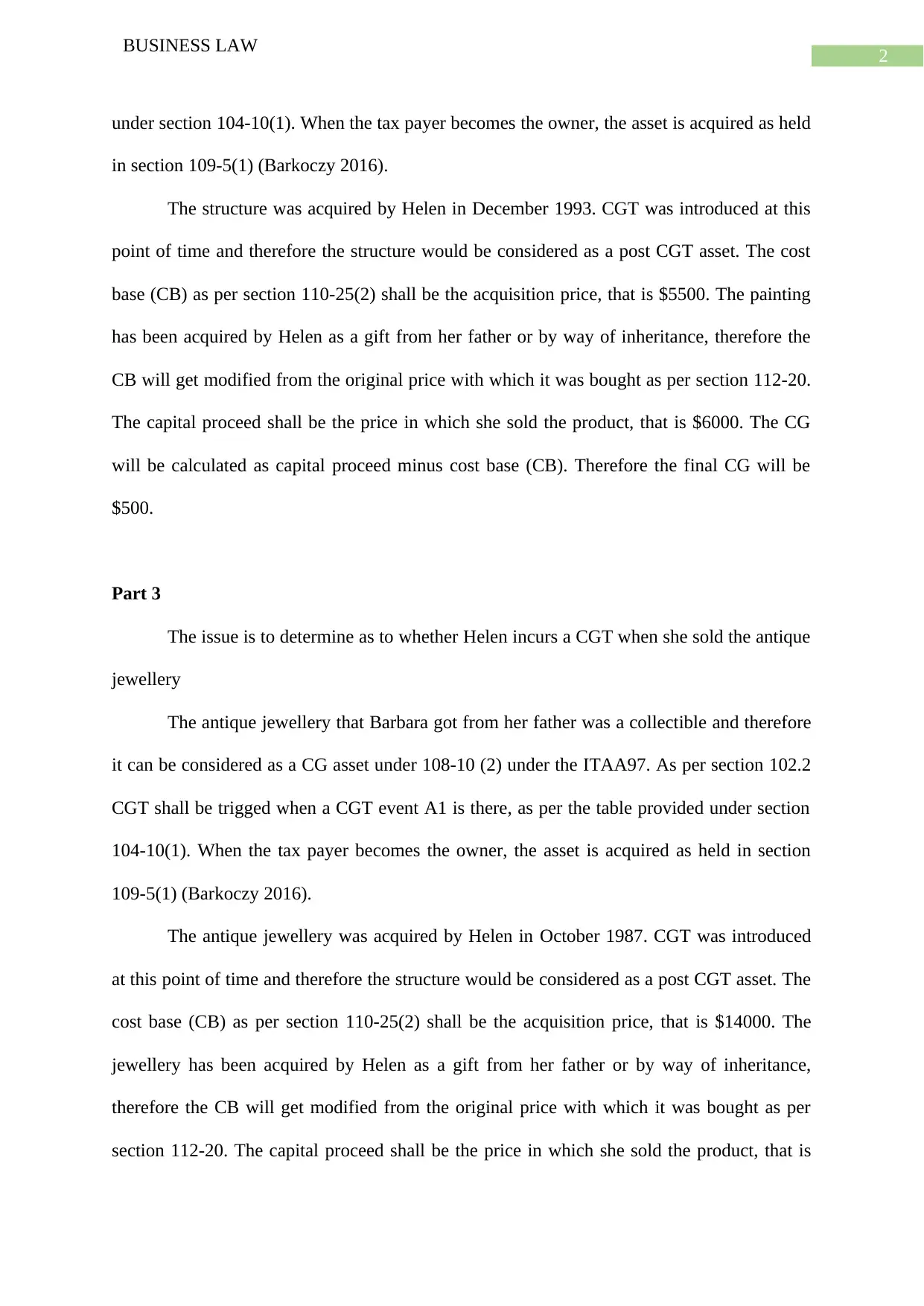
2
BUSINESS LAW
under section 104-10(1). When the tax payer becomes the owner, the asset is acquired as held
in section 109-5(1) (Barkoczy 2016).
The structure was acquired by Helen in December 1993. CGT was introduced at this
point of time and therefore the structure would be considered as a post CGT asset. The cost
base (CB) as per section 110-25(2) shall be the acquisition price, that is $5500. The painting
has been acquired by Helen as a gift from her father or by way of inheritance, therefore the
CB will get modified from the original price with which it was bought as per section 112-20.
The capital proceed shall be the price in which she sold the product, that is $6000. The CG
will be calculated as capital proceed minus cost base (CB). Therefore the final CG will be
$500.
Part 3
The issue is to determine as to whether Helen incurs a CGT when she sold the antique
jewellery
The antique jewellery that Barbara got from her father was a collectible and therefore
it can be considered as a CG asset under 108-10 (2) under the ITAA97. As per section 102.2
CGT shall be trigged when a CGT event A1 is there, as per the table provided under section
104-10(1). When the tax payer becomes the owner, the asset is acquired as held in section
109-5(1) (Barkoczy 2016).
The antique jewellery was acquired by Helen in October 1987. CGT was introduced
at this point of time and therefore the structure would be considered as a post CGT asset. The
cost base (CB) as per section 110-25(2) shall be the acquisition price, that is $14000. The
jewellery has been acquired by Helen as a gift from her father or by way of inheritance,
therefore the CB will get modified from the original price with which it was bought as per
section 112-20. The capital proceed shall be the price in which she sold the product, that is
BUSINESS LAW
under section 104-10(1). When the tax payer becomes the owner, the asset is acquired as held
in section 109-5(1) (Barkoczy 2016).
The structure was acquired by Helen in December 1993. CGT was introduced at this
point of time and therefore the structure would be considered as a post CGT asset. The cost
base (CB) as per section 110-25(2) shall be the acquisition price, that is $5500. The painting
has been acquired by Helen as a gift from her father or by way of inheritance, therefore the
CB will get modified from the original price with which it was bought as per section 112-20.
The capital proceed shall be the price in which she sold the product, that is $6000. The CG
will be calculated as capital proceed minus cost base (CB). Therefore the final CG will be
$500.
Part 3
The issue is to determine as to whether Helen incurs a CGT when she sold the antique
jewellery
The antique jewellery that Barbara got from her father was a collectible and therefore
it can be considered as a CG asset under 108-10 (2) under the ITAA97. As per section 102.2
CGT shall be trigged when a CGT event A1 is there, as per the table provided under section
104-10(1). When the tax payer becomes the owner, the asset is acquired as held in section
109-5(1) (Barkoczy 2016).
The antique jewellery was acquired by Helen in October 1987. CGT was introduced
at this point of time and therefore the structure would be considered as a post CGT asset. The
cost base (CB) as per section 110-25(2) shall be the acquisition price, that is $14000. The
jewellery has been acquired by Helen as a gift from her father or by way of inheritance,
therefore the CB will get modified from the original price with which it was bought as per
section 112-20. The capital proceed shall be the price in which she sold the product, that is
⊘ This is a preview!⊘
Do you want full access?
Subscribe today to unlock all pages.

Trusted by 1+ million students worldwide
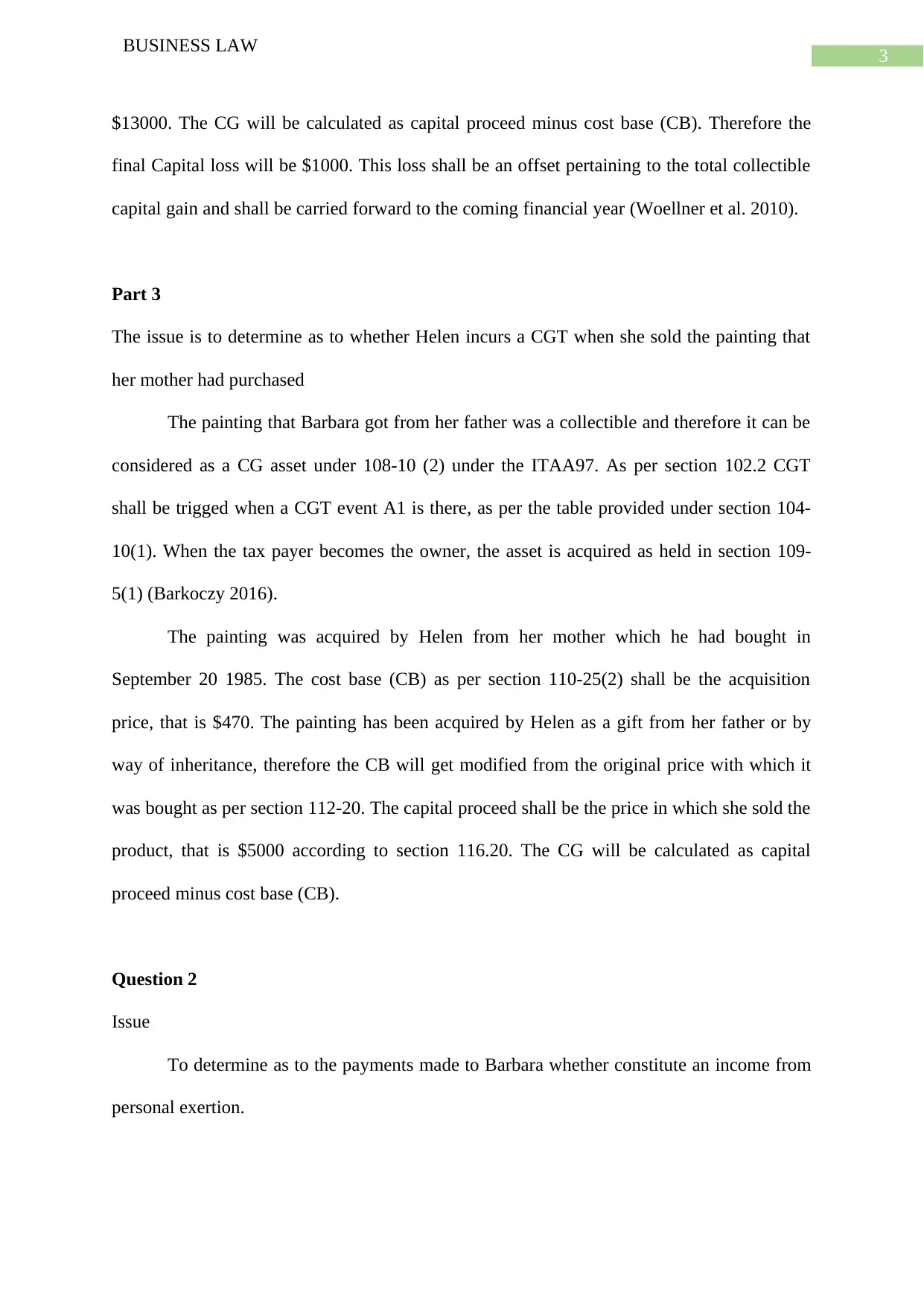
3
BUSINESS LAW
$13000. The CG will be calculated as capital proceed minus cost base (CB). Therefore the
final Capital loss will be $1000. This loss shall be an offset pertaining to the total collectible
capital gain and shall be carried forward to the coming financial year (Woellner et al. 2010).
Part 3
The issue is to determine as to whether Helen incurs a CGT when she sold the painting that
her mother had purchased
The painting that Barbara got from her father was a collectible and therefore it can be
considered as a CG asset under 108-10 (2) under the ITAA97. As per section 102.2 CGT
shall be trigged when a CGT event A1 is there, as per the table provided under section 104-
10(1). When the tax payer becomes the owner, the asset is acquired as held in section 109-
5(1) (Barkoczy 2016).
The painting was acquired by Helen from her mother which he had bought in
September 20 1985. The cost base (CB) as per section 110-25(2) shall be the acquisition
price, that is $470. The painting has been acquired by Helen as a gift from her father or by
way of inheritance, therefore the CB will get modified from the original price with which it
was bought as per section 112-20. The capital proceed shall be the price in which she sold the
product, that is $5000 according to section 116.20. The CG will be calculated as capital
proceed minus cost base (CB).
Question 2
Issue
To determine as to the payments made to Barbara whether constitute an income from
personal exertion.
BUSINESS LAW
$13000. The CG will be calculated as capital proceed minus cost base (CB). Therefore the
final Capital loss will be $1000. This loss shall be an offset pertaining to the total collectible
capital gain and shall be carried forward to the coming financial year (Woellner et al. 2010).
Part 3
The issue is to determine as to whether Helen incurs a CGT when she sold the painting that
her mother had purchased
The painting that Barbara got from her father was a collectible and therefore it can be
considered as a CG asset under 108-10 (2) under the ITAA97. As per section 102.2 CGT
shall be trigged when a CGT event A1 is there, as per the table provided under section 104-
10(1). When the tax payer becomes the owner, the asset is acquired as held in section 109-
5(1) (Barkoczy 2016).
The painting was acquired by Helen from her mother which he had bought in
September 20 1985. The cost base (CB) as per section 110-25(2) shall be the acquisition
price, that is $470. The painting has been acquired by Helen as a gift from her father or by
way of inheritance, therefore the CB will get modified from the original price with which it
was bought as per section 112-20. The capital proceed shall be the price in which she sold the
product, that is $5000 according to section 116.20. The CG will be calculated as capital
proceed minus cost base (CB).
Question 2
Issue
To determine as to the payments made to Barbara whether constitute an income from
personal exertion.
Paraphrase This Document
Need a fresh take? Get an instant paraphrase of this document with our AI Paraphraser
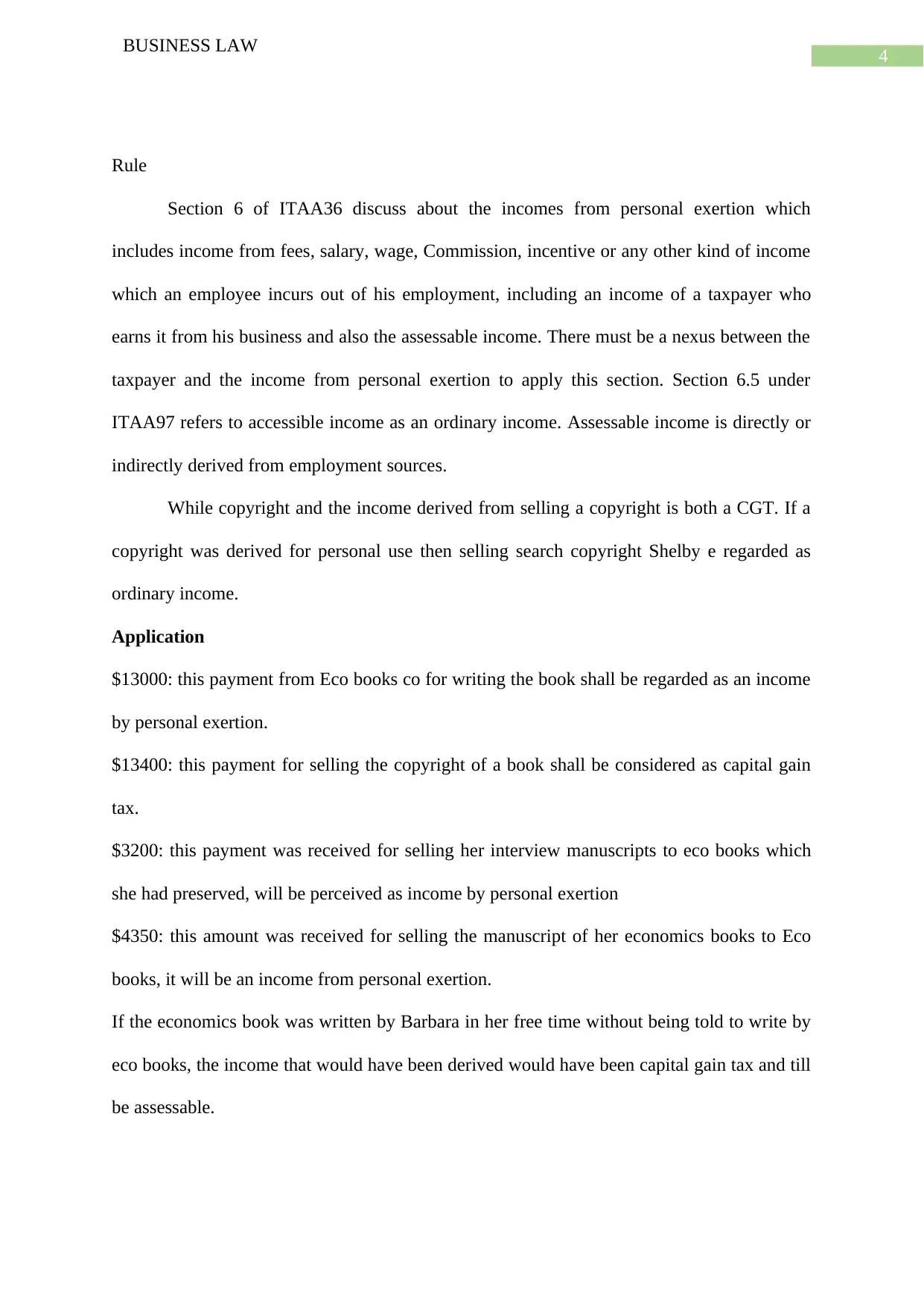
4
BUSINESS LAW
Rule
Section 6 of ITAA36 discuss about the incomes from personal exertion which
includes income from fees, salary, wage, Commission, incentive or any other kind of income
which an employee incurs out of his employment, including an income of a taxpayer who
earns it from his business and also the assessable income. There must be a nexus between the
taxpayer and the income from personal exertion to apply this section. Section 6.5 under
ITAA97 refers to accessible income as an ordinary income. Assessable income is directly or
indirectly derived from employment sources.
While copyright and the income derived from selling a copyright is both a CGT. If a
copyright was derived for personal use then selling search copyright Shelby e regarded as
ordinary income.
Application
$13000: this payment from Eco books co for writing the book shall be regarded as an income
by personal exertion.
$13400: this payment for selling the copyright of a book shall be considered as capital gain
tax.
$3200: this payment was received for selling her interview manuscripts to eco books which
she had preserved, will be perceived as income by personal exertion
$4350: this amount was received for selling the manuscript of her economics books to Eco
books, it will be an income from personal exertion.
If the economics book was written by Barbara in her free time without being told to write by
eco books, the income that would have been derived would have been capital gain tax and till
be assessable.
BUSINESS LAW
Rule
Section 6 of ITAA36 discuss about the incomes from personal exertion which
includes income from fees, salary, wage, Commission, incentive or any other kind of income
which an employee incurs out of his employment, including an income of a taxpayer who
earns it from his business and also the assessable income. There must be a nexus between the
taxpayer and the income from personal exertion to apply this section. Section 6.5 under
ITAA97 refers to accessible income as an ordinary income. Assessable income is directly or
indirectly derived from employment sources.
While copyright and the income derived from selling a copyright is both a CGT. If a
copyright was derived for personal use then selling search copyright Shelby e regarded as
ordinary income.
Application
$13000: this payment from Eco books co for writing the book shall be regarded as an income
by personal exertion.
$13400: this payment for selling the copyright of a book shall be considered as capital gain
tax.
$3200: this payment was received for selling her interview manuscripts to eco books which
she had preserved, will be perceived as income by personal exertion
$4350: this amount was received for selling the manuscript of her economics books to Eco
books, it will be an income from personal exertion.
If the economics book was written by Barbara in her free time without being told to write by
eco books, the income that would have been derived would have been capital gain tax and till
be assessable.
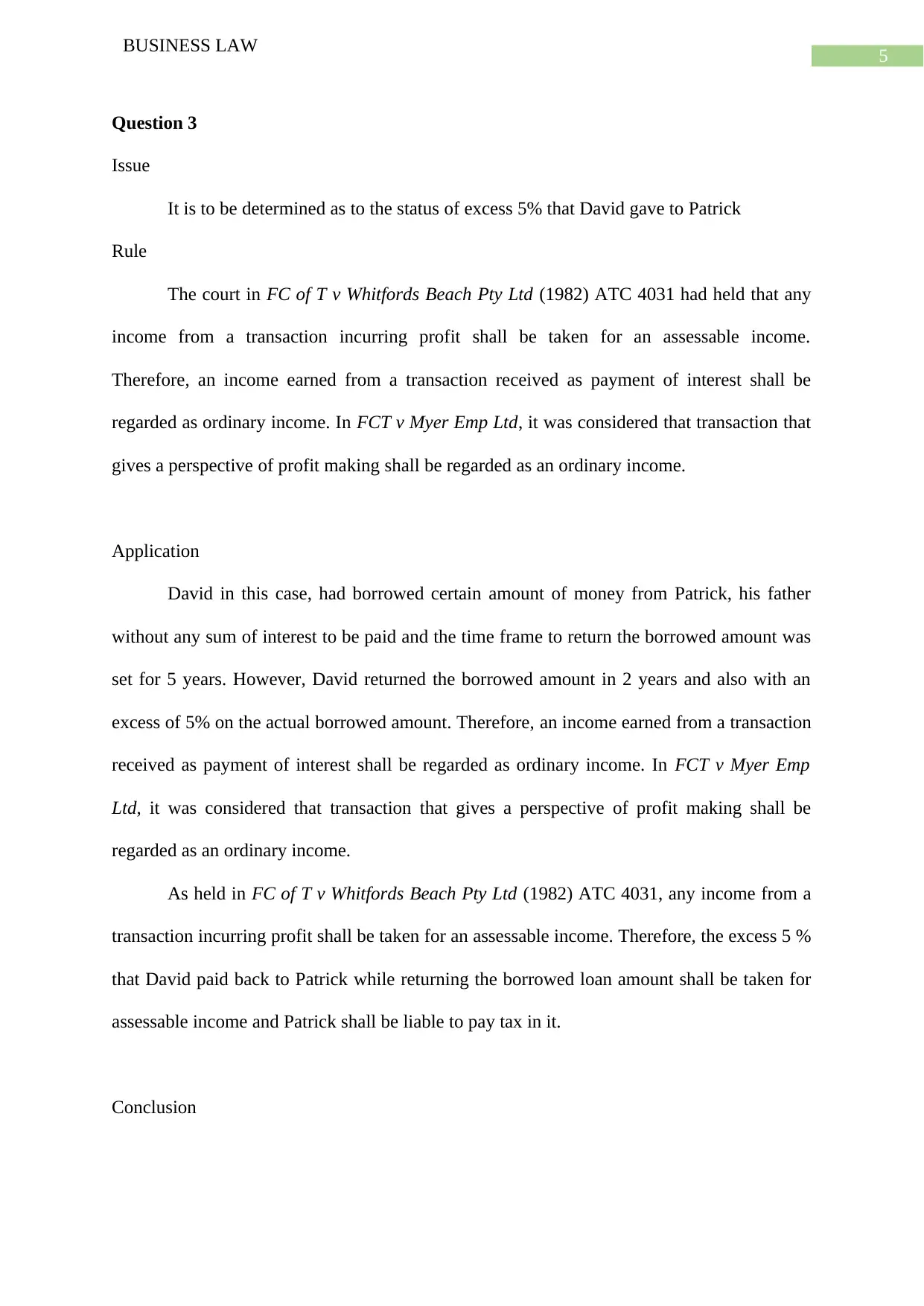
5
BUSINESS LAW
Question 3
Issue
It is to be determined as to the status of excess 5% that David gave to Patrick
Rule
The court in FC of T v Whitfords Beach Pty Ltd (1982) ATC 4031 had held that any
income from a transaction incurring profit shall be taken for an assessable income.
Therefore, an income earned from a transaction received as payment of interest shall be
regarded as ordinary income. In FCT v Myer Emp Ltd, it was considered that transaction that
gives a perspective of profit making shall be regarded as an ordinary income.
Application
David in this case, had borrowed certain amount of money from Patrick, his father
without any sum of interest to be paid and the time frame to return the borrowed amount was
set for 5 years. However, David returned the borrowed amount in 2 years and also with an
excess of 5% on the actual borrowed amount. Therefore, an income earned from a transaction
received as payment of interest shall be regarded as ordinary income. In FCT v Myer Emp
Ltd, it was considered that transaction that gives a perspective of profit making shall be
regarded as an ordinary income.
As held in FC of T v Whitfords Beach Pty Ltd (1982) ATC 4031, any income from a
transaction incurring profit shall be taken for an assessable income. Therefore, the excess 5 %
that David paid back to Patrick while returning the borrowed loan amount shall be taken for
assessable income and Patrick shall be liable to pay tax in it.
Conclusion
BUSINESS LAW
Question 3
Issue
It is to be determined as to the status of excess 5% that David gave to Patrick
Rule
The court in FC of T v Whitfords Beach Pty Ltd (1982) ATC 4031 had held that any
income from a transaction incurring profit shall be taken for an assessable income.
Therefore, an income earned from a transaction received as payment of interest shall be
regarded as ordinary income. In FCT v Myer Emp Ltd, it was considered that transaction that
gives a perspective of profit making shall be regarded as an ordinary income.
Application
David in this case, had borrowed certain amount of money from Patrick, his father
without any sum of interest to be paid and the time frame to return the borrowed amount was
set for 5 years. However, David returned the borrowed amount in 2 years and also with an
excess of 5% on the actual borrowed amount. Therefore, an income earned from a transaction
received as payment of interest shall be regarded as ordinary income. In FCT v Myer Emp
Ltd, it was considered that transaction that gives a perspective of profit making shall be
regarded as an ordinary income.
As held in FC of T v Whitfords Beach Pty Ltd (1982) ATC 4031, any income from a
transaction incurring profit shall be taken for an assessable income. Therefore, the excess 5 %
that David paid back to Patrick while returning the borrowed loan amount shall be taken for
assessable income and Patrick shall be liable to pay tax in it.
Conclusion
⊘ This is a preview!⊘
Do you want full access?
Subscribe today to unlock all pages.

Trusted by 1+ million students worldwide
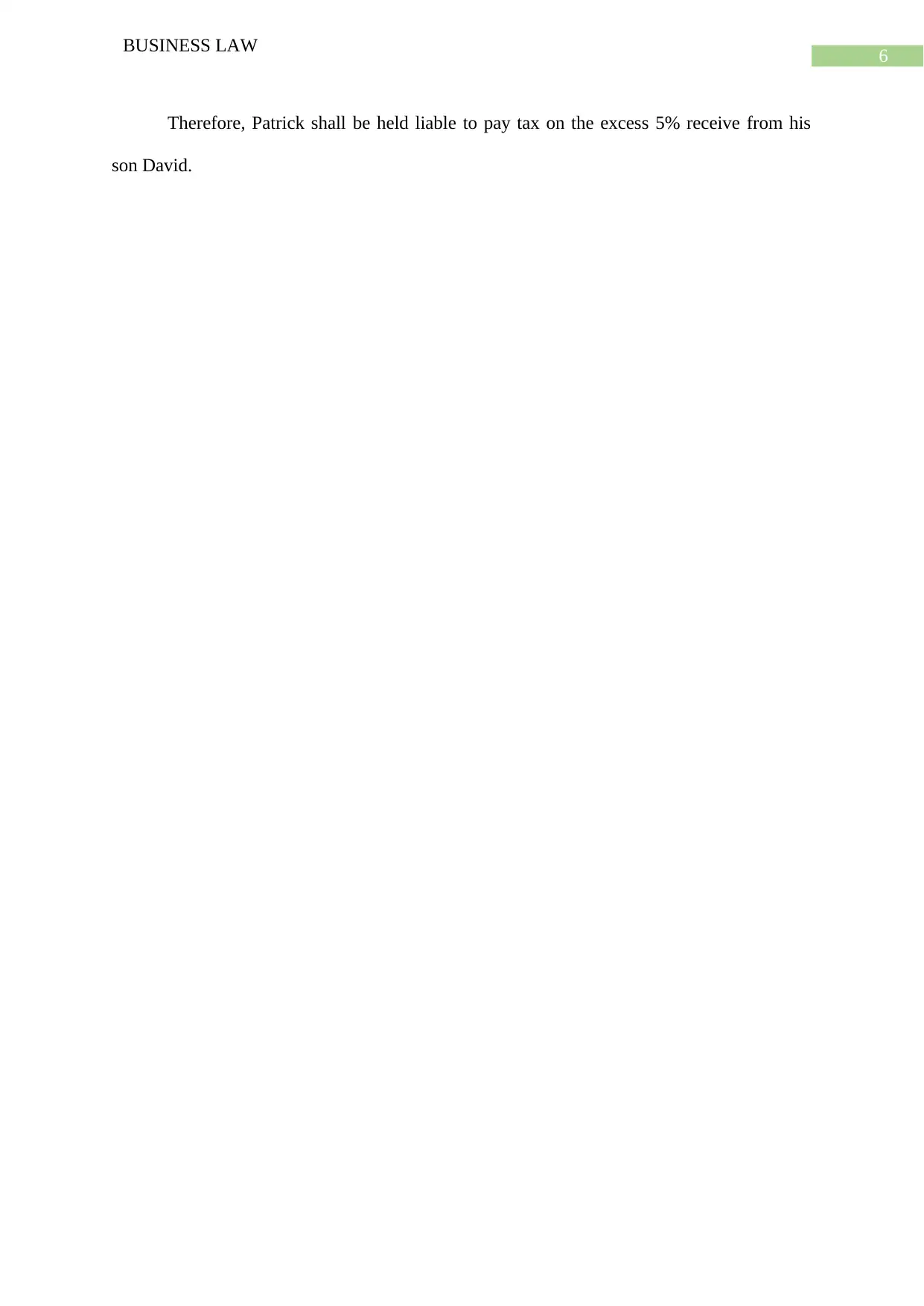
6
BUSINESS LAW
Therefore, Patrick shall be held liable to pay tax on the excess 5% receive from his
son David.
BUSINESS LAW
Therefore, Patrick shall be held liable to pay tax on the excess 5% receive from his
son David.
Paraphrase This Document
Need a fresh take? Get an instant paraphrase of this document with our AI Paraphraser
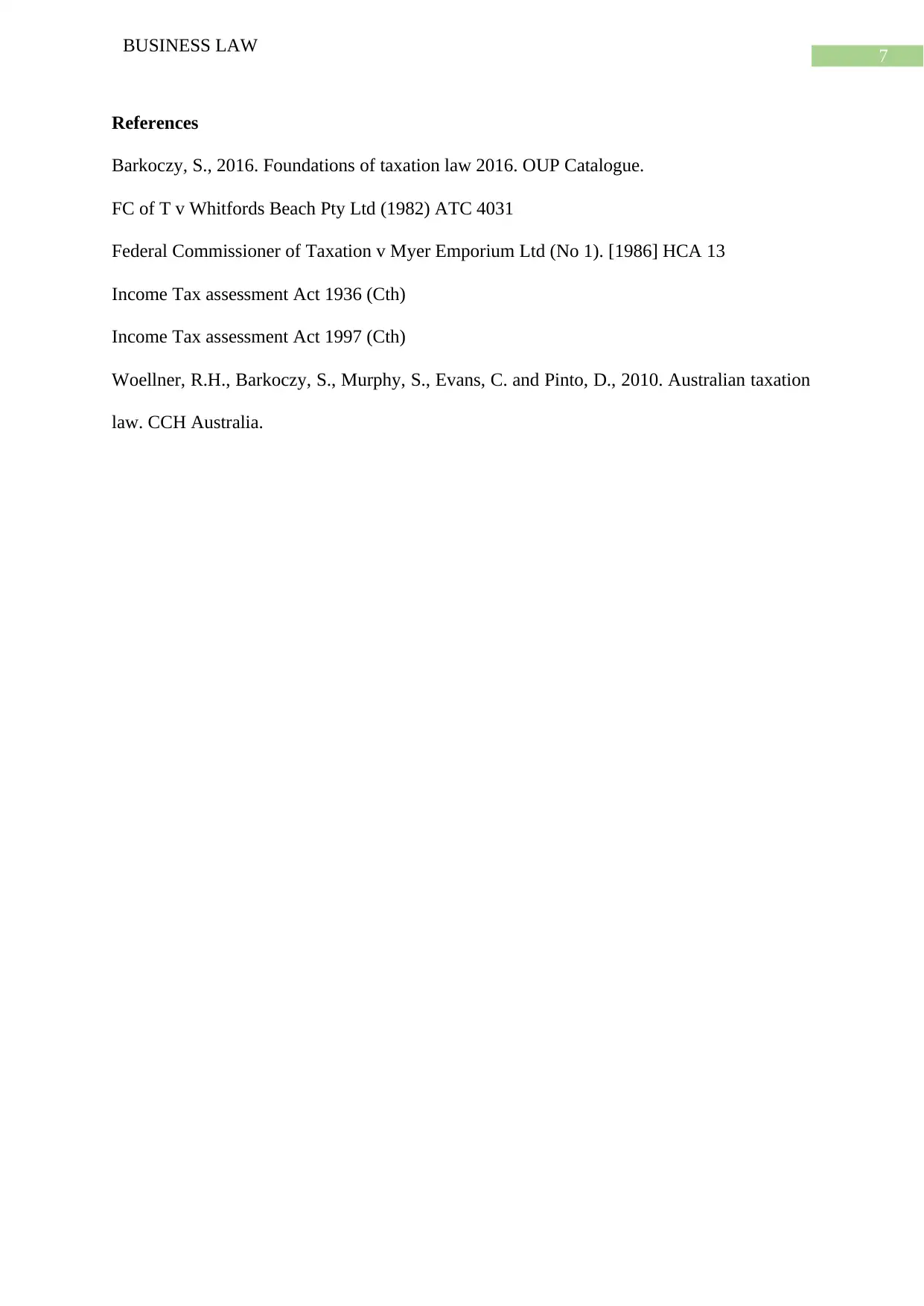
7
BUSINESS LAW
References
Barkoczy, S., 2016. Foundations of taxation law 2016. OUP Catalogue.
FC of T v Whitfords Beach Pty Ltd (1982) ATC 4031
Federal Commissioner of Taxation v Myer Emporium Ltd (No 1). [1986] HCA 13
Income Tax assessment Act 1936 (Cth)
Income Tax assessment Act 1997 (Cth)
Woellner, R.H., Barkoczy, S., Murphy, S., Evans, C. and Pinto, D., 2010. Australian taxation
law. CCH Australia.
BUSINESS LAW
References
Barkoczy, S., 2016. Foundations of taxation law 2016. OUP Catalogue.
FC of T v Whitfords Beach Pty Ltd (1982) ATC 4031
Federal Commissioner of Taxation v Myer Emporium Ltd (No 1). [1986] HCA 13
Income Tax assessment Act 1936 (Cth)
Income Tax assessment Act 1997 (Cth)
Woellner, R.H., Barkoczy, S., Murphy, S., Evans, C. and Pinto, D., 2010. Australian taxation
law. CCH Australia.
1 out of 8
Related Documents
Your All-in-One AI-Powered Toolkit for Academic Success.
+13062052269
info@desklib.com
Available 24*7 on WhatsApp / Email
![[object Object]](/_next/static/media/star-bottom.7253800d.svg)
Unlock your academic potential
Copyright © 2020–2025 A2Z Services. All Rights Reserved. Developed and managed by ZUCOL.





